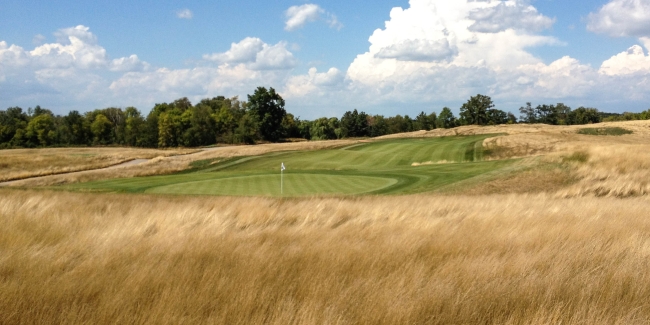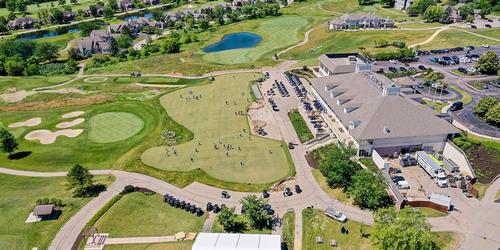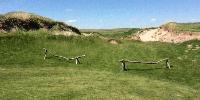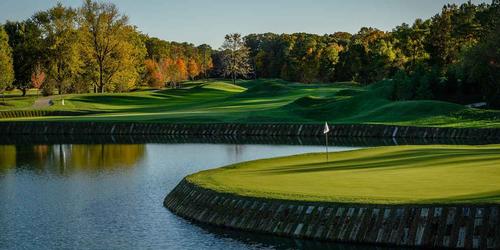
Erin Hills: Teeing It Up for the 2017 US Open
The Course Is Tournament Ready
By Paul Seifert
In rural Southeast Wisconsin is one of the state's true golfing gems: Erin Hills.
The rugged terrain of Erin Hills looks and feels like the most natural land in the world. The course and its layout, though, are far from natural. In fact, the past seven years have brought radical changes to this beautiful piece of land.
It has always been the goal of current owner, Andy Ziegler, and the course's former owner, Bob Lang, to host a championship event at Erin Hills. That dream has been realized in the past year, when following a rigorous selection process Erin Hills was named the site of the 2017 US Open.
Championship events are no new thing for Erin Hills. In 2011, it was the site of the US Amateur. Watching it on ESPN for four days whet my appetite to experience this amazing course for myself, and it did not disappoint.
I had the privilege of spending over an hour with Rich Tock, Director of Operations for Erin Hills, prior to my round. Rich is a legend in Wisconsin golf, having previously been the Head PGA Golf Professional at Ozaukee Country Club for 21 years. He is also one heck of a golfer, holding the record for low round at a number of great Wisconsin courses, including the Milwaukee Country Club. Rich is a man who knows golf, and his passion for the sport and the future of his course is unequivocal.
It was a real eye-opener hearing about all the details that go in to making a course tournament-ready. When Ziegler purchased the course from Lang in November of 2009, the wheels were in motion to secure the event. Narrowed down from a group of eight contending courses, Erin Hills was chosen for the US Open over Shinnecock, Cog Hill and five others.
Its vast landscape, championship event specific features like a virtual highway (which will support camera crews and logistical teams, and runs around and through the heart of the course), and the ability to handle the 75,000 fans per day that are expected tee up Erin Hills beautifully for the demands by Mike Davis and his USGA governing body.
One of the first tasks for new ownership was the removal of all paths and gravel, which were subsequently seeded for fescue. The course simultaneously removed 325 trees and built a new maintenance building, practice facilities and entrance road. They then moved the one home on the course to the property's outer limits [and donated it to a worthy cause], resulting in a lack of any homes or manmade structures other than integral course facilities.
The fairways at Erin Hills, like those at the Straits Course at Whistling Straits, are fine fescue that is closely shorn and roll like nothing I had ever played on. There is still a small amount of poiana grass in the fairways, but it is being phased out to provide an entirely fescue experience. Some areas of the fairways are slightly browning, and I was interested to learn that this is dormant fescue (not dead grass).
The greens and tees are entirely bent grass. The greens normally run at an eleven to eleven and a half on the stimp meter, but are sped up to twelve to thirteen for tournament play.
Because of the fine fescue on the course, motorized and pull carts are not allowed at Erin Hills. The eighteen-hole trek is eight and a half miles walking down the center of each fairway. Had I been wearing a GPS tracking device, it would have shown significantly more mileage for my round.
In the past three years, the course has ripped out and reseeded every bit of fescue on the course. This was not only done in the fescue areas just off the fairways, but on the hillsides and meadows, as well.
The hillsides of the moraine landscape at Erin Hills have been covered in glacial rock for centuries. Liz, who provided us with a tour of "The Village," worked on the maintenance crew from the age of 13, coming by the course after school to clear stones from the fields and hillsides. It is this type of commitment and attention to detail that has helped secure the most prestigious of all golf events for Erin Hills. It is also the demands and suggestions by the USGA that have not only closed the course down for several extended periods of time, but have drastically changed the course's play.
The beautiful ninth hole, for example, was previously the course's "Bye hole." It was the nineteenth hole that was played to settle up bets in square matches, and was not part of the course's original eighteen because it was felt that it did not fit well with the rest of the course. Adding this wonderful hole (Rich's favorite on the course, and certainly one of mine), and removing the previous tenth hole (which consisted of all blind shots), played a part in bringing the course's par score down from 73 to 72.
Other changes played a part, including turning the seventh hole in to a par five (previously a par three with a blind tee shot), and changing ten from a par five to four. Other "minor changes" included adding a new bunker on three, a new back tee to extend eight, and adding a new tee on five.
Following the removal of most trees in 2010, the course reworked the edges of all their bunkers, reestablishing steeper and more structurally fortified fronts. Their perimeters jut in all directions, and are almost never circular in shape, requiring tough stances to get bunkered shots out.
Not only is the land at Erin Hills set up ideally to host a large-scale event, but the course itself is adaptable to be played at an unlimited number of lengths and levels of difficulty. The swirling winds in such an open area can make stretches of holes either unbelievably difficult, or thankfully more playable. Eleven through fifteen for us were straight into the teeth of the wind. With accuracy at a premium, they were challenging to say the least.
With five to six sets of tees on each hole, the multitude of length combinations at Erin Hills is staggering. The 2011 US Amateur played to 7,750 yards, but the course can be extended to over 8,000. This will be the longest course played in the history of the US Open. For average players like myself, the 6,700-yard green tees were challenging enough.
Do not expect to score what you would at a "normal" golf course here. Erin Hills is far from a normal course, and if you are going to spend the money, make sure you enjoy it, too.
Three of the four players in our group employed caddies. What does that cost, you ask? A caddy costs $50 per person, plus tip. I expected a good tip to be around $25, but the minimum is $45.
Our caddies, Tyler and Blaine, were excellent. Not only do they have a wealth of local knowledge, but they are invaluable in the short game. The greens roll perfectly true. Not only are they fast, but they have a lot of break. Downhill putts are slippery, and uphill putts require a bit of extra oomph. After making my initial read, I would ask and the caddies would tell me the right line within seconds. Within inches, they were right each time.
Erin Hills has a world class practice facility, including a huge driving range that features an abundance of practice greens, and laser rangefinders to help lock in distances. As my cousin, Frank, said, "You know you're at a nice course when the range balls don't have lines on them." With the range balls being brand new TaylorMade Pentas, this is a very nice place.
The championship range we used today is the same that will be used for the US Open. Standing room and grandstands will abound in the long fescue area that backs the tee area, and there is a third teeing area on the far side of the driving range for players who are looking to get away from the crowds. The everyday practice tees are located to the right of the championship ones. The course rotates stations frequently to consistently provide fresh grass to warm up on.
To the left of the championship tee boxes is a vast chipping area, complete with bunkers and fairway to approach from to practice shots inside one hundred yards. I did not have time to use this area, but would love to spend hours on it any other day. The practice green is large, and features a variety of slopes that will be found on the course. The only practice greens I have found that compare in size and variety of putts were at Torrey Pines and Whistling Straits (both championship event sites).
Dial in your shots on the range, because the course requires precision. Starting with the first hole tee shot, the fairways are tight - they will be drawn in even tighter for the US Open - and anything off the fairways can get awfully difficult. The rough is long, and the plethora of craggy fairway bunkers look brutal to hit out of.
The course is right now as it will be for the 2017 US Open. Erin Hills made the aforementioned changes required to host this event in just three years what would have taken any other course five to seven.
Starting with the first hole, tee shots at Erin Hills are almost all intimidating. The first is a medium-length par five that plays to 539 yards from the green tees. The tee shot should be played to the right side of the fairway, and the second shot over the central fairway bunker. The approach plays shorter than it looks. While playing to the left brings in the marsh area and a steep drop-off from the green, hitting short to the right can filter on to the putting surface.
One of our caddies actually stood on the left hillside to give an aiming target on the second hole. The tee shot is blind, but if the fairway is found it will leave a short approach in to a minute, highly elevated green.
I enjoyed the distances from the green tees of the par threes at Erin Hills. Six is the longest, at 188 yards, while the others set up between 150 and 175. There are no 200-plus yard knee knockers like at Whistling Straits and many other championship courses. That being said, the tips will obviously play considerably longer for the US Open.
The eighth is Rich's favorite par four on the course, and I can understand why. The tee shot is mostly blind, and fatal if hit to the right side. If you can hit long, or tee up a strong draw, drive over the hill to find a long, wide fairway that runs right to left.
Most of the greens at Erin Hills are elevated, but the green on eight rises skyward about forty yards. Take an extra club or two for any chance of clearing the front-side traps. The hill beyond the green can be used as a backstop if hit too long, but falling short presents all kinds of danger. I found myself on this hill with a hellacious downhill chip. My caddy, Tyler, suggested an aiming spot, which seemed impossible, but when executed left me with a one-foot gimme following a 25-yard chip. These guys are unbelievable.
It was very helpful having the caddies' trained eyes help with finding wayward balls, too. I had a lot of them in my round, losing nine in the fescue and one in the water.
Anyone who has played Erin Hills will inevitably ask, "How did you manage to lose a ball in the water?" I asked the caddies prior to teeing off on the par three ninth if they'd ever seen someone hit the water from those tee boxes. The answer was two laughs, followed by two no's. I then sliced a seven-iron high in to the wind, bouncing twice in to one of the course's only water hazards. Apparently, I am now a record holder of some kind at Erin Hills.
Blaine shared that he once caddied for a guy who shot 240 there. Although this didn't make me feel great about my ailing game, I did stop stressing as much over poor tee shots.
By now you should preclude that there are very few water hazards at Erin Hills. That is true, but as a friend of mine who played the weekend before warned me: "Consider the fescue water." Every shot hit in the fescue might as well be at the bottom of a pond, and it is everywhere. The fescue is long, entangling, and drowns everything.
Visit the halfway house after finishing up on nine, and make sure to enjoy one of their all beef hot dogs for just four dollars. The pretzel bun alone makes it worth the price.
The back nine starts with a very long par four. At 450 yards from the green tees, the drive is blind to a wide, risen fairway that filters down and right, leaving a long approach to a green perched beyond a spattering of sand traps.
At 170 yards from the green tees, the thirteenth is a fairly straightforward par three. The two ponds over the hitting area should not come in to play, but if you are destined to hit water, it will probably be on thirteen. The huge traps left of the green are scary, while the front and right sides fall off quickly. The right play is to the middle of the green. If only it was that easy!
Fourteen is an awesome par five that plays 505 yards from the green tees. It is 615 from the tips, though, so do not expect to see Tiger hitting it with driver-wedge. The central fairway bunker requires 220 to clear and is a great aiming point for long hitters. The fairway slopes downward beyond this trap, leaving an approach of 220-260. Favor the left side on your approach for a chance to run on to the green, which runs quickly from left to right.
Take a minute to enjoy the scenery from the tee boxes on fifteen. Overlooking the fourteenth green, this elevated area affords a beautiful view of the majority of the course and its surroundings, including the majestic Holy Hill National Shrine of Mary, Help of Christians basilica on the skyline. Cardinal Timothy Dolan held mass there this past April, and it is one of sixty minor basilicas in the United States.
Erin Hills is actually one of two great Wisconsin golf courses that have views of Holy Hill. The other is the nearby Washington County in Hartford - another top 100 track in the country (number 31 municipal course, according to GolfWeek). With all due respect to Washington County, which I love, it is not in the same conversation as Erin Hills.
With a strong wind in to our faces, and a narrow fairway over a slight forced carry, the fifteenth hole was my undoing for the day. After taking two penalties, I two-putted for nine and cannot provide much guidance on this hole from experience, but can tell you that it is a really hard hole with a very highly elevated green.
Finishing the run of the eleventh through fifteenth holes was a huge relief, as on the sixteenth hole we finally got a little wind in our favor. The sixteenth is a very unique par three, and its uniqueness is noticed after leaving the tee area. Much like the sixth on the Irish Course at Whistling Straits, anything not on the green will be bunkered or lost. Three out of four of us had great tee shots here, fortunately, and two-putted for par. The other went left and was swallowed by fescue.
With the wind from our back-right on the two last holes, all systems were go for long drives. The seventeenth has a tight fairway, but opens up slightly to the right in line with the oak tree on that side of the fairway. The fescue was short on that side, so I was mercilessly able to find my tee shot and save par.
The eighteenth is one of the most beautiful finishing holes I have played, and also one of the most challenging. At 620 yards from the green tees (660 from the tips), it is also one of the longest.
Listening to Rich tell me about this finishing hole before my round got me excited to play it. With a good drive, the fairway bends right at around 250-300 yards out. Trying to hit the green in two from this area will inevitably result in a lost ball in the forced carry over fescue that serves as a wetland. The second shot has to be played far right toward the central fairway sand trap. The fairway on eighteen extends considerably in that direction, and leaves a wedge in to a green that is risen and lined on the left with deep sand traps. Long and left runs off the green quickly.
The view on this approach is breathtaking, with the clubhouse, village, and American and Erin Hills flags in the near distance, and Holy Hill on the horizon. It is so memorable that a friend of mine from my Thursday night golf league hired a painter to capture the vista with him on the eighteenth green.
One of the things I find interesting about Erin Hills is the consideration that went in to the course's mapping. Tremendous care was taken to ensure that the opening holes have the sun rising at the player's back, while the finishing holes have the sun setting from behind. Hundreds of hole layouts and combinations were considered when planning this course, and the result is both considerate and enjoyable.
Never have I felt more like I was completely away from it all on a golf course than at Erin Hills. During the eight and a half mile hike there is not a single house to be seen, and the drastic changes in elevation provide ample exercise, while watching the fescue waving in the wind is truly soothing to the soul.
The Village at Erin Hills was built in 2010, and added 28 beds to the property for stay and play opportunities. There are not many hotels in the vicinity of the course, and the reasonable rates for their cabins provide an ideal setting to enjoy an extended golf weekend. The cabins are luxurious, and feature four king-sized bedrooms, each with its own bathroom. They have outdoor patios and card tables, flat-screen televisions and full kitchens.
What I would enjoy most on one of these weekends, other than the golf, would be enjoying a glass of scotch or bourbon on the clubhouse's new back patio around the gas fire pits.
In addition to the cabins, the village features a large second clubhouse, which will be used as the locker room and on-site dining area for major events. It was fascinating to get an intimate look at this building, as well as the boardroom where Rich, Mike Davis, and others discuss the present and future of one of our country's great golf destinations.
If it was less expensive, I would play Erin Hills every day for the rest of my life. For well over $200, though, I will have to stash some money aside and hope for the opportunity to redeem myself here before watching it on TV again in 2017.
I have been to Torrey Pines, Blackwolf Run and Whistling Straits, and this is undoubtedly a deserving destination for golf's greatest championship. The course is set up beautifully to host golf's greatest tournament and field, as well as the 300,000-plus spectators expected to make the journey. It will sure be amazing watching it all unfold at Erin Hills, the best course I have ever played.
Revised: 08/10/2012 - Article Viewed 35,344 Times
- View Course Profile
About: Paul Seifert
![]() Paul Seifert is an often-proclaimed golf addict, and publisher of WiscoSportsAddict, a blog started in August, 2011, as a forum dedicated to reviewing courses and sharing the best of the best in the state with other avid Wisconsin golfers.
Paul Seifert is an often-proclaimed golf addict, and publisher of WiscoSportsAddict, a blog started in August, 2011, as a forum dedicated to reviewing courses and sharing the best of the best in the state with other avid Wisconsin golfers.
Having started playing in Hartland-area leagues at the age of 12, Paul is a classic over-thinker who averages between 80 and 120 rounds per year, and despite carrying a 13-handicap, is committed to the ongoing improvement of his game.
A health care equipment salesman by day, Paul does not claim to be an expert golfer, but is certainly an expert golf enthusiast who loves the sport and enjoys the writing, research, statistics and photography that make for interesting golf conversation.
Contact Paul Seifert:
GolfWisconsin.com - Contributor














